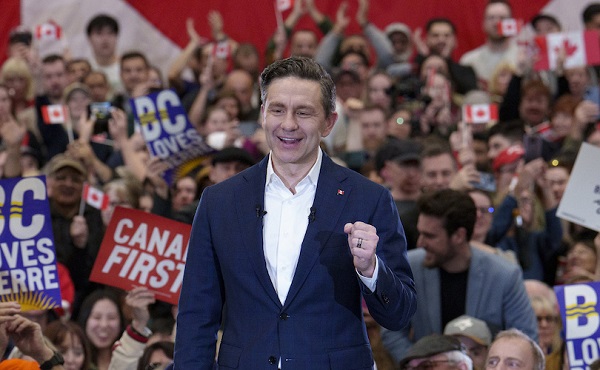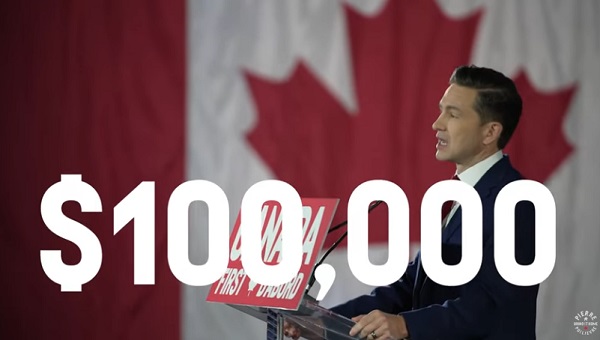Alberta
WEF? Capital NO: Danielle Smith replies to claims she endorses Justin Trudeau’s green agenda

Submitted by Danielle Smith
Say No to the WEF and Trudeau Agenda!In politics, negative attacks are still an unfortunate part of the process. I usually just tune them out. However, I did have to do a bit of a double take on the latest attack by my friends, Travis Toews and Brian Jean, who accused me of endorsing…wait for it…Justin Trudeau’s radical green agenda.
Now, that’s a new one I haven’t heard before! Until yesterday I was accused of being too tough on Ottawa…what changed gentlemen? |
|
|
|
|
Danielle Smith and 300 friends in Grande Prairie, Alberta. August 6th. |
|
|
Obviously, their accusation is absurd on many levels, but I thought this might be a good opportunity to share my thoughts with you on the dangers of Justin Trudeau’s WEF-inspired radical climate agenda, and why we need to tackle environmental issues in a much different way – the Alberta way. First off, the WEF is an anti-democratic group of woke elites that advocate for dangerous socialist policies that cause high inflation, food shortages and a lack of affordable energy, which in turn, leads to mass poverty, especially in the developing world. There is no question what their agenda is – they want to shut down our energy and agriculture industries as fast as they can. We need to join with allies, like Scott Moe in Saskatchewan, and stand up for our farmers and our provincial rights. |
|
|
|
|
Justin Trudeau has openly adopted the WEF agenda and has instituted a wealth of policies meant to drive up the cost of energy and food production so he can meet arbitrary and aggressive WEF CO2 emissions targets. Let me be perfectly clear – As Premier, no individual in my government or provincial agency will be permitted to associate with the WEF in any manner. Secondly, WEF inspired policies imposed upon us by Ottawa will not be enforced by any Provincial agency under authority of the Alberta Sovereignty Act. |
|
|
|
|
The fact is the Federal carbon tax, the recent announcement of a 30% reduction in fertilizer use by farmers, and the proposed arbitrary emissions cap on our energy sector are scams that do nothing to improve the environment. You don’t improve the environment or reduce emissions by destroying livelihoods and causing food shortages. We can, however, lower emissions and pollutants the right way, the Alberta way – through Alberta technology and exporting our clean Alberta energy to the world. Our largest oilsands producers have proposed a pioneering project, called Pathways, to use carbon tech and small modular nuclear to dramatically reduce all types of emissions from oilsands production. Further, we must get Alberta LNG and our other clean energy products to Asia, Europe and the US to replace reliance on higher polluting fuels such as coal, wood and dung. Our forestry, ranching and farming sectors are also proud to provide nature based solutions to offset emissions, and they deserve recognition and credit for providing this service to the world. These initiatives – advancing Alberta technology and exporting our clean energy to the world – will do more for the environment than all of the harmful virtue signaling policies of the WEF and Justin Trudeau combined – and will do so while creating jobs and wealth, rather than unemployment and poverty. I invite my friends, Travis Toews and Brian Jean, to stop the silly attacks and join with me in fighting Justin Trudeau, Rachel Notley and their WEF Agenda together! – Danielle Smith |
Alberta
Alberta takes big step towards shorter wait times and higher quality health care

From the Fraser Institute
On Monday, the Smith government announced that beginning next year it will change the way it funds surgeries in Alberta. This is a big step towards unlocking the ability of Alberta’s health-care system to provide more, better and faster services for the same or possibly fewer dollars.
To understand the significance of this change, you must understand the consequences of the current (and outdated) approach.
Currently, the Alberta government pays a lump sum of money to hospitals each year. Consequently, hospitals perceive patients as a drain on their budgets. From the hospital’s perspective, there’s little financial incentive to serve more patients, operate more efficiently and provide superior quality services.
Consider what would happen if your local grocery store received a giant bag of money each year to feed people. The number of items would quickly decline to whatever was most convenient for the store to provide. (Have a favourite cereal? Too bad.) Store hours would become less convenient for customers, alongside a general decline in overall service. This type of grocery store, like an Alberta hospital, is actually financially better off (that is, it saves money) if you go elsewhere.
The Smith government plans to flip this entire system on its head, to the benefit of patients and taxpayers. Instead of handing out bags of money each year to providers, the new system—known as “activity-based funding”—will pay health-care providers for each patient they treat, based on the patient’s particular condition and important factors that may add complexity or cost to their care.
This turns patients from a drain on budgets into a source of additional revenue. The result, as has been demonstrated in other universal health-care systems worldwide, is more services delivered using existing health-care infrastructure, lower wait times, improved quality of care, improved access to medical technologies, and less waste.
In other words, Albertans will receive far better value from their health-care system, which is currently among the most expensive in the world. And relief can’t come soon enough—for example, last year in Alberta the median wait time for orthopedic surgeries including hip and knee replacements was 66.8 weeks.
The naysayers argue this approach will undermine the province’s universal system and hurt patients. But by allowing a spectrum of providers to compete for the delivery of quality care, Alberta will follow the lead of other more successful universal health-care systems in countries such as Australia, Germany, the Netherlands and Switzerland and create greater accountability for hospitals and other health-care providers. Taxpayers will get a much better picture of what they’re paying for and how much they pay.
Again, Alberta is not exploring an untested policy. Almost every other developed country with universal health care uses some form of “activity-based funding” for hospital and surgical care. And remember, we already spend more on health care than our counterparts in nearly all of these countries yet endure longer wait times and poorer access to services generally, in part because of how we pay for surgical care.
While the devil is always in the details, and while it’s still possible for the Alberta government to get this wrong, Monday’s announcement is a big step in the right direction. A funding model that puts patients first will get Albertans more of the high-quality health care they already pay for in a timelier fashion. And provide to other provinces an example of bold health-care reform.
Alberta
Alberta’s embrace of activity-based funding is great news for patients

 From the Montreal Economic Institute
From the Montreal Economic Institute
Alberta’s move to fund acute care services through activity-based funding follows best practices internationally, points out an MEI researcher following an announcement made by Premier Danielle Smith earlier today.
“For too long, the way hospitals were funded in Alberta incentivized treating fewer patients, contributing to our long wait times,” explains Krystle Wittevrongel, director of research at the MEI. “International experience has shown that, with the proper funding models in place, health systems become more efficient to the benefit of patients.”
Currently, Alberta’s hospitals are financed under a system called “global budgeting.” This involves allocating a pre-set amount of funding to pay for a specific number of services based on previous years’ budgets.
Under the government’s newly proposed funding system, hospitals receive a fixed payment for each treatment delivered.
An Economic Note published by the MEI last year showed that Quebec’s gradual adoption of activity-based funding led to higher productivity and lower costs in the province’s health system.
Notably, the province observed that the per-procedure cost of MRIs fell by four per cent as the number of procedures performed increased by 22 per cent.
In the radiology and oncology sector, it observed productivity increases of 26 per cent while procedure costs decreased by seven per cent.
“Being able to perform more surgeries, at lower costs, and within shorter timelines is exactly what Alberta’s patients need, and Premier Smith understands that,” continued Mrs. Wittevrongel. “Today’s announcement is a good first step, and we look forward to seeing a successful roll-out once appropriate funding levels per procedure are set.”
The governments expects to roll-out this new funding model for select procedures starting in 2026.
* * *
The MEI is an independent public policy think tank with offices in Montreal, Ottawa, and Calgary. Through its publications, media appearances, and advisory services to policymakers, the MEI stimulates public policy debate and reforms based on sound economics and entrepreneurship.
-

 2025 Federal Election1 day ago
2025 Federal Election1 day agoRCMP memo warns of Chinese interference on Canadian university campuses to affect election
-

 Alberta2 days ago
Alberta2 days agoAlberta takes big step towards shorter wait times and higher quality health care
-

 2025 Federal Election24 hours ago
2025 Federal Election24 hours agoResearchers Link China’s Intelligence and Elite Influence Arms to B.C. Government, Liberal Party, and Trudeau-Appointed Senator
-

 Business2 days ago
Business2 days agoTrump raises China tariffs to 125%, announces 90-day pause for countries who’ve reached out to negotiate
-

 2025 Federal Election1 day ago
2025 Federal Election1 day agoThe status quo in Canadian politics isn’t sustainable for national unity
-

 Business1 day ago
Business1 day agoScott Bessent Says Trump’s Goal Was Always To Get Trading Partners To Table After Major Pause Announcement
-

 2025 Federal Election21 hours ago
2025 Federal Election21 hours agoTwo Canadian police unions endorse Pierre Poilievre for PM
-

 2025 Federal Election1 day ago
2025 Federal Election1 day agoPoilievre Announces Plan To Cut Taxes By $100,000 Per Home










